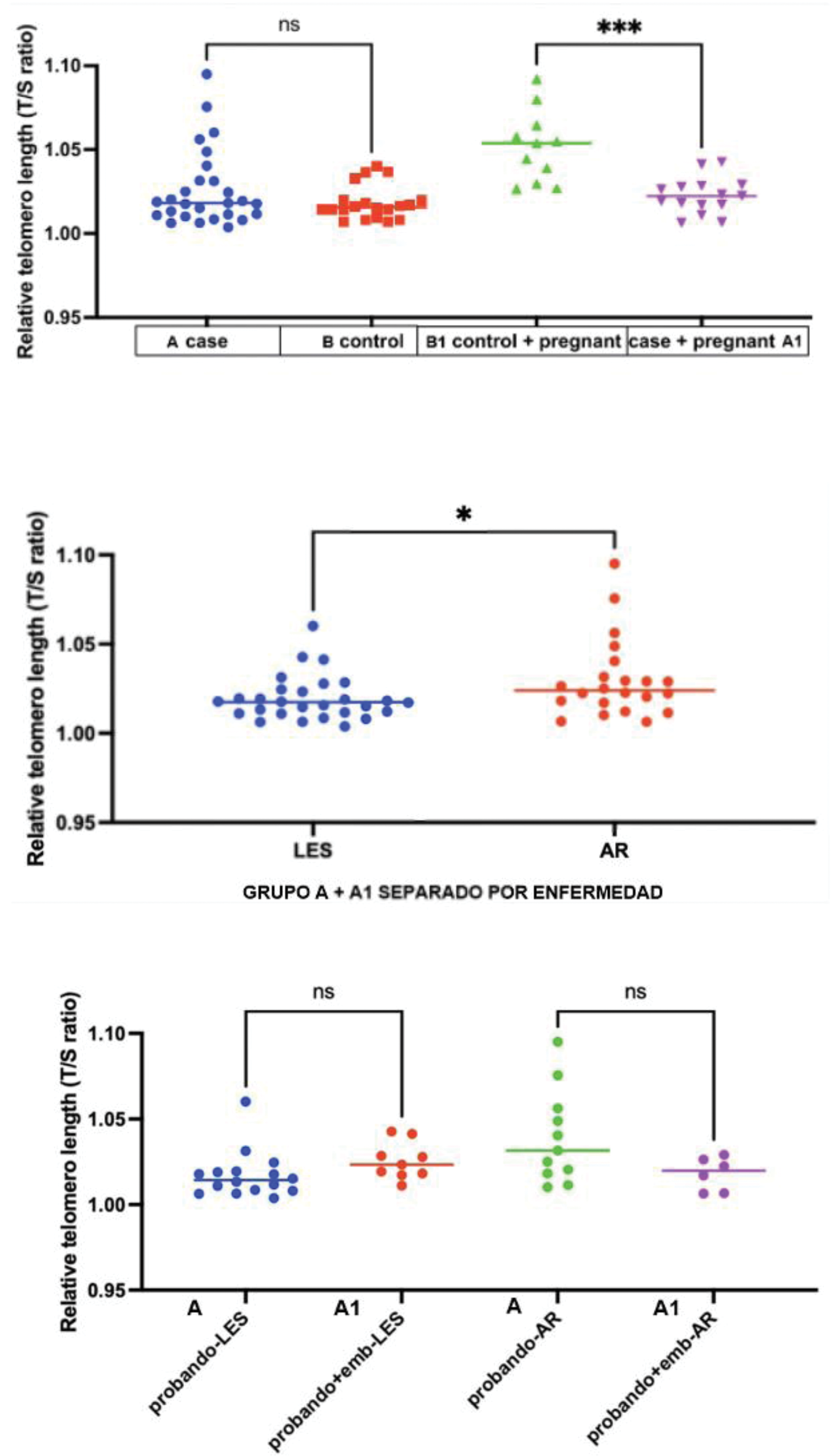

Background: Telomeres play a crucial role in genome integrity and stability, forming protective caps at chromosomal ends with tandem sequences (TTAGGG). They shorten with each cell division cycle, serving as indicators of cellular aging processes. Their shortening increases in the presence of oxidative stress and inflammation, conditions present in rheumatoid arthritis (RA) and systemic lupus erythematosus (SLE). Telomere length (LTL) is highly heritable, with a greater correlation observed between the mother’s LTL and the newborn’s due to the shared environment during gestation, which influences telomere length.
Objectives: To determine telomere length in leukocytes of healthy women and women with autoimmune rheumatic diseases, with and without pregnancy, through molecular analysis.
Methods: A cohort of 80 women was evaluated, and divided into cases and controls (2:1 ratio) across four groups:
Group A: Cases with RA or SLE (n = 40).
A1: Pregnant women with RA or SLE (n = 10).
Group B: Controls (n = 20).
B1: Pregnant controls (n = 10).
All participants underwent clinical evaluations in genetics, rheumatology, obstetrics, and nutrition, along with sociodemographic data collection and mental health assessments for depression and anxiety. Blood samples were collected as follows:
Groups A1/B1 (pregnant women): Two 3 mL EDTA samples for molecular analysis, one taken during pregnancy and the second postpartum.
Groups A/B: A single 3 mL EDTA sample for molecular analysis. Additionally, in Group B , 5 mL of serum in a red-cap tube was collected for serological analysis of disease activity (C-reactive protein [CRP], complement levels [C3, C4], and anti-DNA antibodies).
Molecular LTL analysis was performed using relative quantification through quantitative PCR, amplifying the telomeric repeat sequence and a single-copy gene (RPLP0). Genomic DNA was extracted from peripheral blood leukocytes. PCR conditions were: 10 min at 95°C, 45 cycles of 15 sec at 95°C, and 1 min at 60°C. Melting curve analysis was conducted with a 20-sec cycle at 95°C, 15 sec at 50°C, and ramping to 98°C at 0.1°C/sec. Telomere shortening estimation was calculated as follows: [ECt(telomeres)/ECt(PRLP0)]−1=2−ΔCt.
Results: No significant differences in LTL were observed between patients in Group A, whether by disease type or compared with Groups A1 or B. However, significant differences were found in Group B1 compared to other groups, showing longer LTL in healthy pregnant women. Groups A1 and B1 presented smoking during the first trimester of pregnancy, higher rates of depression, sedentary lifestyles, and a lack of meditation practices. Group B1 also exhibited higher obesity rates, exposure to environmental pollution, and poor diets (Table 1 and Figure 1).
Conclusion: This is the first study examining LTL in women with and without pregnancy, comparing RA and SLE cases. No significant LTL differences were observed between cases and controls, even though one-third of cases exhibited active disease. Only Group B1 showed longer LTL, despite the higher frequency of risk factors such as smoking, obesity, pollution, poor diet, and depression. Elevated estrogen levels during pregnancy, previously reported to influence longer LTL, might play a role; however, estrogen levels were not measured in this study. One-third of these women have a family history of other autoimmune conditions, underscoring the importance of genetic counseling to understand recurrence risks and the impact of inheritance on their health and that of their offspring.
REFERENCES: [1] Haque S, Rakieh C, Marriage F, Ho P, Gorodkin R, Teh LS, et al. Shortened telomere length in patients with systemic lupus erythematosus. Arthritis Rheum. 2013 May;65(5):1319-23. doi: 10.1002/art.37895. PMID: 23400670.
[2] Lazarides C, Epel ES, Lin J, Blackburn EH, Voelkle MC, Buss C, et al. Maternal pro-inflammatory state during pregnancy and newborn leukocyte telomere length: A prospective investigation. Brain Behav Immun. 2019 Aug; 80:419-26. doi: 10.1016/j.bbi.2019.04.021. PMID: 30974172; PMCID: PMC7954441.
Relative telomere length by groups. RA: Rheumatoid Arthritis; SLE: Systemic Lupus Erythematosus.

Analyzed Variables
| Variable | Group A | Group A1 | Group B | Group B1 |
|---|---|---|---|---|
| Smoking status | 9.6% | 17.6% | 10% | 18% |
| Obesity | 16.2% | 29.4% | 0% | 36% |
| Pollution | 35.4% | 52.9% | 30% | 81% |
| Stress | 77.4% | 70.5% | 85% | 18% |
| Depression | 5% | 20% | 15% | 20% |
| Anxiety | 7.5% | 20% | 20% | 10% |
| Deficient diet | 51.6% | 29.4% | 15% | 54.5% |
| Antioxidant | 29% | 23.5% | 15% | 9% |
| Excersice | 41.9% | 23.5% | 70% | 36.3% |
| Meditation | 16.1% | 0% | 25% | 0% |
| Family History | 38.7% | 29.4% | 25% | 0% |
| TOTAL | 40 | 10 | 20 | 10 |
Acknowledgements: NIL.
Disclosure of Interests: None declared.
© The Authors 2025. This abstract is an open access article published in Annals of Rheumatic Diseases under the CC BY-NC-ND license (